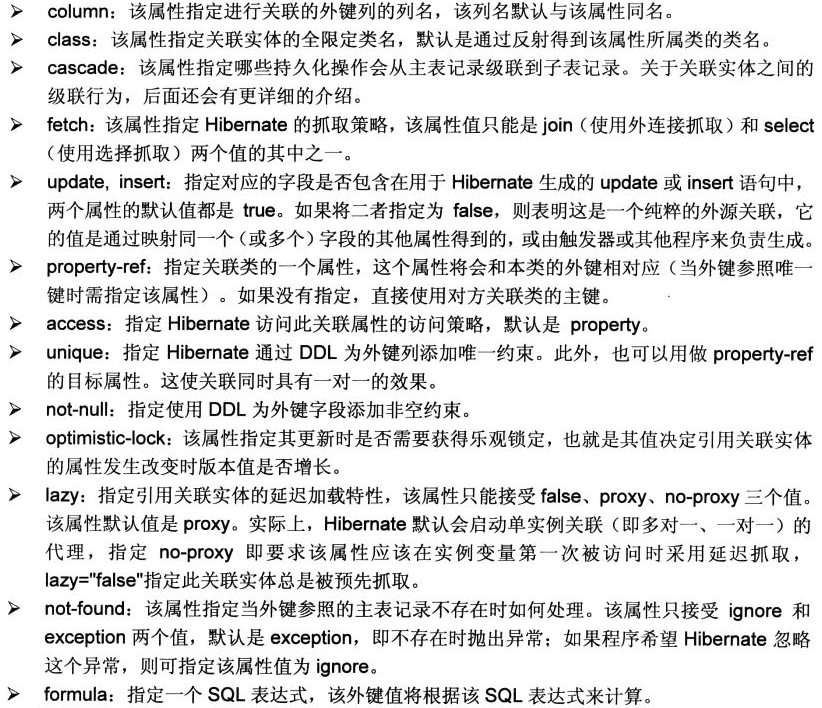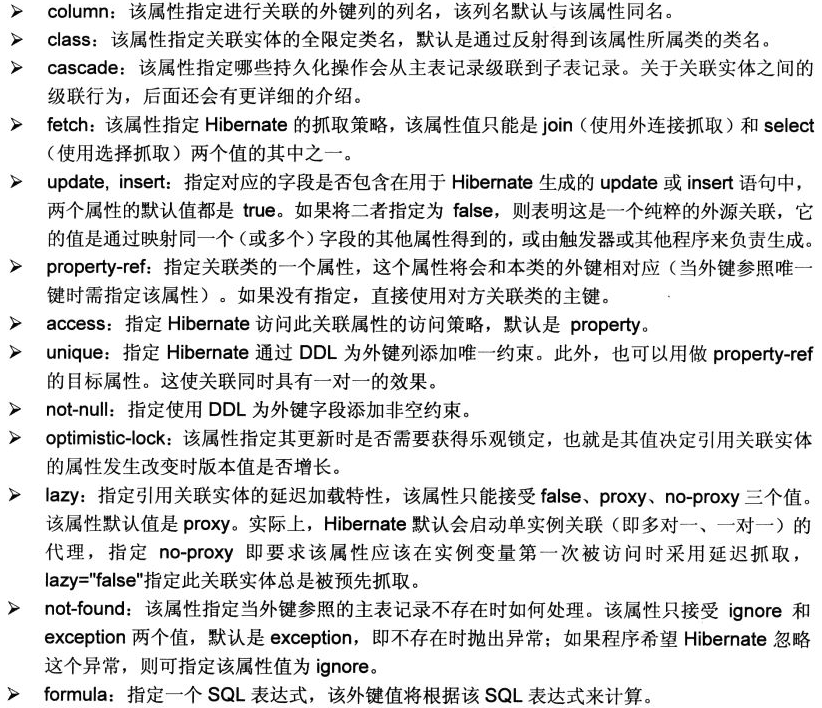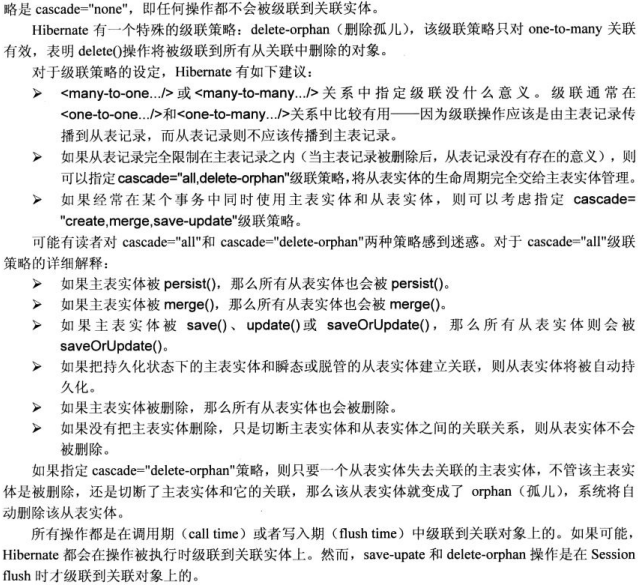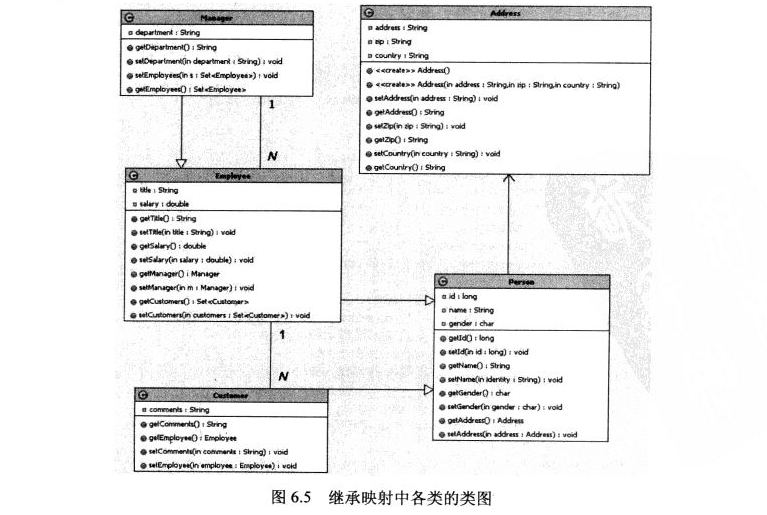【Java EE (Struts2 + Spring + Hibernate)开发】 :Hibernate(二)之【关联映射|继承映射|批量处理】
本文地址:http://blog.csdn.net/shanglianlm/article/details/49975511
1 Hibernate 的关联映射
1-1 单项 N-1 关联
public class Person
{
//标识属性
private Integer id;
//Person的name属性
private String name;
//保留Person的age属性
private int age;
//引用关联实体的属性
private Address address;
....
//address属性的setter和getter方法
public void setAddress(Address address)
{
this.address = address;
}
public Address getAddress()
{
return this.address;
}
}Address.java
public class Address
{
//标识属性
private Integer addressId;
//地址详细信息
private String addressDetail;
//无参数的构造器
public Address()
{
}
//初始化全部属性的构造器
public Address(String addressDetail)
{
this.addressDetail = addressDetail;
}
...
}1-1-1 无连接表的 N-1 关联
Hibernate 使用 < many-to-one …/ > 元素映射 N-1 的关联实体。
< many-to-one …/ > 元素的可选属性:
<?xml version="1.0" encoding="GBK"?>
<!-- 指定Hibernate的DTD信息 -->
<!DOCTYPE hibernate-mapping PUBLIC
"-//Hibernate/Hibernate Mapping DTD 3.0//EN"
"http://www.hibernate.org/dtd/hibernate-mapping-3.0.dtd">
<hibernate-mapping package="org.crazyit.app.domain">
<!-- 映射Person持久化类-->
<class name="Person" table="person_inf">
<!-- 映射标识属性 -->
<id name="id" column="person_id">
<!-- 定义主键生成器策略 -->
<generator class="identity"/>
</id>
<!-- 用于映射普通属性 -->
<property name="name" type="string"/>
<property name="age" type="int"/>
<!-- 用于映射N-1关联实体,指定关联实体类为Address
指定外键列名为address_id,并指定级联全部操作 -->
<many-to-one name="address" cascade="create"
class="Address" column="address_id"/>
</class>
</hibernate-mapping>Address 无需访问 Person 端,所以 Address 类的映射文件无需改变。
<?xml version="1.0" encoding="GBK"?>
<!-- 指定Hibernate的DTD信息 -->
<!DOCTYPE hibernate-mapping PUBLIC
"-//Hibernate/Hibernate Mapping DTD 3.0//EN"
"http://www.hibernate.org/dtd/hibernate-mapping-3.0.dtd">
<hibernate-mapping package="org.crazyit.app.domain">
<!-- Address持久化类-->
<class name="Address" table="address_inf">
<!-- 映射标识属性addressid -->
<id name="addressId" column="address_id">
<!-- 指定主键生成器策略 -->
<generator class="identity"/>
</id>
<!-- 映射普通属性addressDetail -->
<property name="addressDetail"/>
</class>
</hibernate-mapping>1-1-2 有连接表的 N-1 关联

<hibernate-mapping package="org.crazyit.app.domain">
<!-- 映射Person持久化类-->
<class name="Person" table="person_inf">
...
<!-- 使用join元素强制使用连接表 -->
<join table="person_address" >
<!-- 映射连接表中参照本表主键的外键列 -->
<key column="person_id"/>
<!-- 映射连接表中参照关联实体的外键列 -->
<many-to-one name="address" cascade="all"
class="Address" column="address_id"/>
</join>
</class>
</hibernate-mapping>1-2 单项 1-1 关联
单向 1-1 只需要在 N-1 原有的 < many-to-one /> 元素增加 unique=”true” 属性即可。
1-2-1 基于外键的单向 1-1
<hibernate-mapping package="org.crazyit.app.domain">
<!-- 映射Person持久化类-->
<class name="Person" table="person_inf">
...
<!-- 用于映射 1-1 关联实体,指定关联实体类为 Address 指定外键列名为address_id,并指定级联全部操作 -->
<many-to-one name="address" cascade="all" unique="true" class="Address" column="address_id"/>
</class>
</hibernate-mapping>1-2-2 有连接表的单向 1-1
<hibernate-mapping package="org.crazyit.app.domain">
<!-- 映射Person持久化类-->
<class name="Person" table="person_inf">
...
<!-- 使用join元素强制使用连接表 -->
<join table="person_address" >
<!-- 映射连接表中参照本表主键的外键列 -->
<key column="person_id"/>
<!-- 映射连接表中参照关联实体的外键列 -->
<many-to-one name="address" cascade="all"
unique="true" class="Address"
column="address_id"/>
</join>
</class>
</hibernate-mapping>1-2-3 基于主键的单向 1-1
<hibernate-mapping package="org.crazyit.app.domain">
<!-- 映射Person持久化类-->
<class name="Person" table="person_inf">
<!-- 映射标识属性person_id -->
<id name="id" column="person_id">
<!-- 基于主键关联时,主键生成策略是foreign,表明根据关联类的主键来生成该实体的主键 -->
<generator class="foreign">
<!-- 指定引用关联实体的属性名 -->
<param name="property">address</param>
</generator>
</id>
<!-- 用于映射普通属性 -->
<property name="name" type="string"/>
<property name="age" type="int"/>
<!-- 下面映射基于主键的1-1关联 -->
<one-to-one name="address"/>
</class>
</hibernate-mapping>1-3 单项 1-N 关联
public class Person
{
...
//1-N关联关系,使用Set来保存关联实体
private Set<Address> addresses = new HashSet<Address>();
...
//addresses属性的setter和getter方法
public void setAddresses(Set<Address> addresses)
{
this.addresses = addresses;
}
public Set<Address> getAddresses()
{
return this.addresses;
}
}1-3-1 无连接表的单向 1-N
<hibernate-mapping package="org.crazyit.app.domain">
<!-- 映射Person持久化类-->
<class name="Person" table="person_inf">
...
<!-- 映射集合属性,集合元素是其他持久化实体没有指定cascade属性 -->
<set name="addresses">
<!-- 指定关联的外键列 -->
<key column="person_id"/>
<!-- 用以映射到关联类属性 -->
<one-to-many class="Address"/>
</set>
</class>
</hibernate-mapping>1-3-2 有连接表的单向 1-N

<hibernate-mapping package="org.crazyit.app.domain">
<!-- 映射Person持久化类-->
<class name="Person" table="person_inf">
...
<!-- 映射集合属性,集合元素是其他持久化实体指定连接表的表名-->
<set name="addresses" table="person_address">
<!-- 指定连接表中参照本表记录的外键列名 -->
<key column="person_id" />
<!-- 使用many-to-many来映射1-N关联,增加unique="true" -->
<many-to-many class="Address" column="address_id" unique="true"/>
</set>
</class>
</hibernate-mapping>1-4 单项 N-N 关联
<hibernate-mapping package="org.crazyit.app.domain">
<!-- 映射Person持久化类-->
<class name="Person" table="person_inf">
...
<!-- 映射集合属性,集合元素是其他持久化实体指定连接表的表名-->
<set name="addresses" table="person_address">
<!-- 指定连接表中参照本表记录的外键列名 -->
<key column="person_id" />
<!-- 使用many-to-many来映射N-N关联 -->
<many-to-many class="Address" column="address_id"/>
</set>
</class>
</hibernate-mapping>1-5 双项 1-N 关联
Person.java
public class Person
{
...
//1-N关联关系,使用Set来保存关联实体
private Set<Address> addresses = new HashSet<Address>();
...
//addresses属性的setter和getter方法
public void setAddresses(Set<Address> addresses)
{
this.addresses = addresses;
}
public Set<Address> getAddresses()
{
return this.addresses;
}
}Address.java
public class Address
{
//标识属性
private int addressId;
//地址详细信息
private String addressDetail;
//记录关联实体的person属性
private Person person;
//无参数的构造器
public Address()
{
}
//初始化全部属性的构造器
public Address(String addressDetail)
{
this.addressDetail = addressDetail;
}
...
//person属性的setter和getter方法
public void setPerson(Person person)
{
this.person = person;
}
public Person getPerson()
{
return this.person;
}
}1-5-1 无连接表的双向 1-N 关联


Person.hbm.xml
<hibernate-mapping package="org.crazyit.app.domain">
<!-- 映射Person持久化类-->
<class name="Person" table="person_inf">
...
<!-- 映射集合属性,集合元素是其他持久化实体没有指定cascade属性,指定不控制关联关系 -->
<set name="addresses" inverse="true">
<!-- 指定关联的外键列 -->
<key column="person_id"/>
<!-- 用以映射到关联类属性 -->
<one-to-many class="Address"/>
</set>
</class>
</hibernate-mapping>Address.hbm.xml
<hibernate-mapping package="org.crazyit.app.domain">
<!-- Address持久化类-->
<class name="Address" table="address_inf">
...
<!-- 必须指定列名为person_id,与关联实体中key元素的column属性值相同 -->
<many-to-one name="person" class="Person"
column="person_id" not-null="true"/>
</class>
</hibernate-mapping>使用
private void testPerson()
{
Session session = HibernateUtil.currentSession();
Transaction tx = session.beginTransaction();
//创建一个Person对象
Person p = new Person();
//设置Person的Name为Yeeku字符串
p.setName("Yeeku");
p.setAge(29);
//持久化Person对象(对应于插入主表记录)
session.save(p);
//创建一个瞬态的Address对象
Address a = new Address("广州天河");
//先设置Person和Address之间的关联关系
a.setPerson(p);
//再持久化Address对象(对应于插入从表记录)
session.persist(a);
//创建一个瞬态的Address对象
Address a2 = new Address("上海虹口");
//先设置Person和Address之间的关联关系
a2.setPerson(p);
//再持久化Address对象(对应于插入从表记录)
session.persist(a2);
tx.commit();
HibernateUtil.closeSession();
}1-5-2 有连接表的双向 1-N 关联


Person.hbm.xml
<hibernate-mapping package="org.crazyit.app.domain">
<!-- 映射Person持久化类-->
<class name="Person" table="person_inf">
...
<!-- 映射集合属性,集合元素是其他持久化实体没有指定cascade属性 -->
<set name="addresses" inverse="true" table="person_address">
<!-- 指定关联的外键列 -->
<key column="person_id"/>
<!-- 用以映射到关联类属性 -->
<many-to-many class="Address" column="address_id" unique="true"/>
</set>
</class>
</hibernate-mapping>Address.hbm.xml
<hibernate-mapping package="org.crazyit.app.domain">
<!-- Address持久化类-->
<class name="Address" table="address_inf">
...
<!-- 显式使用join元素确定连接表 -->
<join table="person_address">
<!-- key映射外键列 -->
<key column="address_id"/>
<!-- 使用many-to-one映射N-1关联实体 -->
<many-to-one name="person" column="person_id" not-null="true"/>
</join>
</class>
</hibernate-mapping>1-6 双项 N-N 关联
Person.java
public class Person
{
...
//1-N关联关系,使用Set来保存关联实体
private Set<Address> addresses = new HashSet<Address>();
...
//addresses属性的setter和getter方法
public void setAddresses(Set<Address> addresses)
{
this.addresses = addresses;
}
public Set<Address> getAddresses()
{
return this.addresses;
}
}Address.java
public class Address
{
//标识属性
private int addressId;
//地址详细信息
private String addressDetail;
//记录关联实体的person属性
private Set<Person> persons = new HashSet<Person>();
//无参数的构造器
public Address()
{
}
//初始化全部属性的构造器
public Address(String addressDetail)
{
this.addressDetail = addressDetail;
}
...
//persons属性的setter和getter方法
public void setPersons(Set<Person> persons)
{
this.persons = persons;
}
public Set<Person> getPersons()
{
return this.persons;
}
}
Person.hbm.xml
<hibernate-mapping package="org.crazyit.app.domain">
<!-- 映射Person持久化类-->
<class name="Person" table="person_inf">
...
<!-- 映射N-N关联实体,两边的table属性值要相同 -->
<set name="addresses" table="person_address">
<!-- 指定关联的外键列 -->
<key column="person_id"/>
<!-- 用以映射到关联类属性 -->
<many-to-many class="Address" column="address_id"/>
</set>
</class>
</hibernate-mapping>Address.hbm.xml
<hibernate-mapping package="org.crazyit.app.domain">
<!-- Address持久化类-->
<class name="Address" table="address_inf">
...
<!-- 映射N-N关联实体,两边的table属性值要相同 -->
<set name="persons" table="person_address">
<!-- 指定关联的外键列 -->
<key column="address_id"/>
<!-- 用以映射到关联类属性 -->
<many-to-many class="Address"
column="person_id"/>
</set>
</class>
</hibernate-mapping>1-7 双项 1-1 关联
1-7-1 基于外键的双向 1-1 关联


Person.hbm.xml
<hibernate-mapping package="org.crazyit.app.domain">
<!-- 映射Person持久化类-->
<class name="Person" table="person_inf">
...
<!-- one-to-one元素映射关联属性,外键列在对方的表内 property-ref指定引用关联类的属性。即:在address属性所属的Address类内,必须有person属性的setter和getter方法 -->
<one-to-one name="address" property-ref="person"/>
</class>
</hibernate-mapping>Address.hbm.xml
<hibernate-mapping package="org.crazyit.app.domain">
<!-- Address持久化类-->
<class name="Address" table="address_inf">
...
<!-- 使用many-to-one映射1-1关联实体 unique="true"确定为1-1-->
<many-to-one name="person" unique="true"
column="person_id" not-null="true"/>
</class>
</hibernate-mapping>两边的映射策略可以互换,但是不能两边都使用相同的元素映射关联属性。
1-7-2 基于主键的双向 1-1 关联
Person.hbm.xml
<hibernate-mapping package="org.crazyit.app.domain">
<!-- 映射Person持久化类-->
<class name="Person" table="person_inf">
...
<!-- 用于映射关联实体 -->
<one-to-one name="address"/>
</class>
</hibernate-mapping>Address.hbm.xml
<hibernate-mapping package="org.crazyit.app.domain">
<!-- Address持久化类-->
<class name="Address" table="address_inf">
<!-- 映射标识属性addressId -->
<id name="addressId" column="address_id">
<!-- 指定foreign主键生成器策略-->
<generator class="foreign">
<!-- 指定该主键值将根据person属性引用的
关联实体的主键来生成-->
<param name="property">person</param>
</generator>
</id>
<!-- 映射普通属性addressdetail -->
<property name="addressDetail"/>
<!-- 用于映射关联实体 -->
<one-to-one name="person"/>
</class>
</hibernate-mapping>1-7-3 有连接表的双向 1-1 关联(不推荐)
Person.hbm.xml
<hibernate-mapping package="org.crazyit.app.domain">
<!-- 映射Person持久化类-->
<class name="Person" table="person_inf">
...
<!-- 使用join元素强制使用连接表 -->
<join table="person_address" inverse="true">
<!-- 映射连接表中参照本实体主键的外键列 -->
<key column="person_id" unique="true"/>
<!-- 映射1-1关联实体 -->
<many-to-one name="address" class="Address"
column="address_id" unique="true"/>
</join>
</class>
</hibernate-mapping>Address.hbm.xml
<hibernate-mapping package="org.crazyit.app.domain">
<!-- Address持久化类-->
<class name="Address" table="address_inf">
...
<!-- 使用join元素强制使用连接表 -->
<join table="person_address" optional="true">
<!-- 映射连接表中参照本实体主键的外键列 -->
<key column="address_id" unique="true"/>
<!-- 映射1-1关联实体 -->
<many-to-one name="person" class="Person"
column="person_id" unique="true"/>
</join>
</class>
</hibernate-mapping>1-8 组合属性包含的关联实体
Address 当作组件属性来处理。
Person.java
public class Person
{
//标识属性
private Integer id;
//Person的name属性
private String name;
//保留Person的age属性
private int age;
//定义一个组件属性
private Address address;
...
//address属性的setter和getter方法
public void setAddress(Address address)
{
this.address = address;
}
public Address getAddress()
{
return this.address;
}
}Address.java
public class Address
{
//标识属性
private int addressId;
//地址详细信息
private String addressDetail;
//定义引用包含实体的属性
private Person person;
//定义保留关联实体的Set
private Set<School> schools = new HashSet<School>();
//无参数的构造器
public Address()
{
}
//初始化addressDetail属性的构造器
public Address(String addressDetail)
{
this.addressDetail = addressDetail;
}
...
//schools属性的setter和getter方法
public void setSchools(Set<School> schools)
{
this.schools = schools;
}
public Set<School> getSchools()
{
return this.schools;
}
}School.java
public class School
{
//定义该学校实体的id属性
private Integer id;
//定义该学校的name属性
private String name;
//无参数的构造器
public School()
{
}
//初始化全部属性的构造器
public School(String name)
{
this.name = name;
}
...
}Person.hbm.xml
<hibernate-mapping package="lee">
<!-- 映射Person持久化类-->
<class name="Person" table="person_inf">
<!-- 映射标识属性 -->
<id name="id" column="person_id">
<!-- 定义主键生成器策略 -->
<generator class="identity"/>
</id>
<!-- 用于映射普通属性 -->
<property name="name" type="string"/>
<property name="age" type="int"/>
<!-- 映射组件元素 -->
<component name="address" class="Address">
<!-- 映射组件的person属性指向包含实体 -->
<parent name="person"/>
<!-- 映射普通属性 -->
<property name="addressDetail"/>
<!-- 映射集合属性,集合元素是其他持久化实体
没有指定cascade属性 -->
<set name="schools">
<!-- 指定关联的外键列 -->
<key column="address_id"/>
<!-- 用以映射到关联类属性 -->
<one-to-many class="School"/>
</set>
</component>
</class>
</hibernate-mapping>没有 Address.hbm.xml 文件
PersonManager.java
public class PersonManager
{
public static void main(String[] args)
{
PersonManager mgr = new PersonManager();
mgr.testPerson();
HibernateUtil.sessionFactory.close();
}
//保存Person和Address对象
private void testPerson()
{
Session session = HibernateUtil.currentSession();
Transaction tx = session.beginTransaction();
//创建一个Person对象
Person p = new Person();
//设置Person的Name为Yeeku字符串
p.setName("Yeeku");
p.setAge(29);
session.save(p);
//创建一个Address对象
Address a = new Address("广州天河");
//设置Person对象的Address属性
p.setAddress(a);
//创建2个School对象
School s1 = new School("疯狂Java项目冲刺班");
School s2 = new School("疯狂Java训练营");
//保存2个School实体
session.save(s1);
session.save(s2);
//设置Address对象和两个School的关联关系
a.getSchools().add(s1);
a.getSchools().add(s2);
tx.commit();
HibernateUtil.closeSession();
}
}1-9 基于复合主键的关联关系(不推荐)
Person.java
public class Person implements java.io.Serializable
{
//定义first属性,作为标识属性的成员
private String first;
//定义last属性,作为标识属性的成员
private String last;
//普通属性age
private int age;
//记录关联实体
private Set<Address> addresses = new HashSet<Address>();
...
//重写equals方法,根据first、last进行判断
public boolean equals(Object obj)
{
if (this == obj)
{
return true;
}
if (obj != null
&& obj.getClass() == Person.class)
{
Person target = (Person)obj;
if (target.getFirst().equals(getFirst())
&& target.getLast().equals(getLast()))
{
return true;
}
}
return false;
}
//重写hashCode方法,根据first、last计算hashCode值
public int hashCode()
{
return getFirst().hashCode() * 13 + getLast().hashCode();
}
}Address.java
public class Address
{
//标识属性
private int addressId;
//地址详细信息
private String addressDetail;
//记录关联实体的person属性
private Person person;
//无参数的构造器
public Address()
{
}
//初始化全部属性的构造器
public Address(String addressDetail)
{
this.addressDetail = addressDetail;
}
...
//person属性的setter和getter方法
public void setPerson(Person person)
{
this.person = person;
}
public Person getPerson()
{
return this.person;
}
}Person.hbm.xml
<hibernate-mapping package="org.crazyit.app.domain">
<class name="Person" table="person_inf">
<!-- 直接使用composite-id映射多列联合主键 -->
<composite-id>
<!-- 映射组件主键里的各属性 -->
<key-property name="first" type="string"/>
<key-property name="last" type="string"/>
</composite-id>
<!-- 映射普通属性 -->
<property name="age" type="int"/>
<!-- 映射关联实体 -->
<set name="addresses" inverse="true"
cascade="all">
<key>
<!-- 映射两个外键列 -->
<column name="first"/>
<column name="last"/>
</key>
<one-to-many class="Address"/>
</set>
</class>
</hibernate-mapping>Address.hbm.xml
<hibernate-mapping package="org.crazyit.app.domain">
<!-- Address持久化类-->
<class name="Address" table="address_inf">
<!-- 映射标识属性addressId -->
<id name="addressId" column="address_id">
<!-- 指定主键生成器策略 -->
<generator class="identity"/>
</id>
<!-- 映射普通属性addressdetail -->
<property name="addressDetail"/>
<!-- 映射关联实体 -->
<many-to-one name="person" class="Person"
not-null="true">
<!-- 映射外键列 -->
<column name="first"/>
<column name="last"/>
</many-to-one>
</class>
</hibernate-mapping>1-10 复合主键的成员属性为关联实体(不推荐)
Order.java
public class Order
{
//标识属性
private Integer orderId;
//订单日期
private Date orderDate;
//关联的的订单项
private Set<OrderItem> items = new HashSet<OrderItem>();
//无参数的构造器
public Order()
{
}
//初始化全部属性的构造器
public Order(Date orderDate)
{
this.orderDate = orderDate;
}
...
//items属性的setter和getter方法
public void setItems(Set<OrderItem> items)
{
this.items = items;
}
public Set<OrderItem> getItems()
{
return this.items;
}
}Product.java
public class Product
{
//标识属性
private Integer productId;
//产品名
private String name;
//无参数的构造器
public Product()
{
}
//初始化全部属性的构造器
public Product(String name)
{
this.name = name;
}
...
}OrderItem.java
public class OrderItem implements java.io.Serializable
{
//下面3个属性将作为联合主键
//定义关联的Order实体
private Order order;
//定义关联的Product实体
private Product product;
//该订单项订购的产品数量
private int count;
//无参数的构造器
public OrderItem()
{
}
//初始化全部属性的构造器
public OrderItem(Order order , Product product , int count)
{
this.order = order;
this.product = product;
this.count = count;
}
...
}OrderItem.hbm.xml
<hibernate-mapping package="org.crazyit.app.domain">
<class name="OrderItem" table="order_item_inf">
<!-- 映射复合主键 -->
<composite-id>
<key-many-to-one name="product"
class="Product" column="product_id" />
<key-many-to-one name="order"
class="Order" column="order_id" />
<key-property name="count" type="int"/>
</composite-id>
</class>
</hibernate-mapping>1-11 持久化的传播性
<!-- 指定 persist() 操作将级联到关联实体 -->
<one-to-many name="person" cascade="persist" />或
<!-- 指定persist()、delete()和lock()操作将级联到关联实体 -->
<one-to-one name="person" cascade="persist, delete, lock" />
2 继承映射
Person.java
public class Person
{
//标识属性
private Integer id;
//定义该Person实体的名字属性
private String name;
//定义该Person实体的性别属性
private char gender;
//定义该Person实体的组件属性:address
private Address address;
...
}Address.java
public class Address
{
//定义该Address的详细信息
private String detail;
//定义该Address的邮编信息
private String zip;
//定义该Address的国家信息
private String country; //无参数的构造器
public Address()
{
}
//初始化全部属性的构造器
public Address(String detail , String zip , String country)
{
this.detail = detail;
this.zip = zip;
this.country = country;
}
...
}Customer.java
//顾客类继承了Person类
public class Customer extends Person
{
//顾客的评论信息
private String comments;
//和员工保持关联关系的属性
private Employee employee;
//无参数的构造器
public Customer()
{
}
//初始化comments属性的构造器
public Customer(String comments)
{
this.comments = comments;
}
...
}Employee.java
//员工类继承了Person类
public class Employee extends Person
{
//定义该员工的职位属性
private String title;
//定义该员工的工资属性
private double salary;
//和顾客保持关联关系的属性
private Set<Customer> customers = new HashSet<Customer>();
//和经理保持关联关系的属性
private Manager manager;
//无参数的构造器
public Employee()
{
}
//初始化全部属性的构造器
public Employee(String title , double salary)
{
this.title = title;
this.salary = salary;
}
...
}Manager.java
//经理类继承员工类
public class Manager extends Employee
{
//定义经理管辖部门的属性
private String department;
//和员工保持关联关系的属性
private Set<Employee> employees = new HashSet<Employee>();
//无参数的构造器
public Manager()
{
}
//初始化全部属性的构造器
public Manager(String department)
{
this.department = department;
}
...
}2-1 采用 subclass 元素的继承映射
- 整个继承树的所有实例都保存在同一个表中。
- 表中需要增加一个辨别性列(discriminator)来区分每行记录归属于哪个类的实例。
- 使用< subclass…/ >来映射子持久化类。
- 每个类映射中都需要指定辨别者列的值。
- 子类增加的属性不可以有非空约束。
Person.hbm.xml
<hibernate-mapping package="org.crazyit.app.domain">
<!-- 映射Person类 -->
<class name="Person" table="person_inf" discriminator-value="普通人">
<!-- 映射标识属性 -->
<id name="id" column="person_id">
<!-- 使用identity的主键生成器策略 -->
<generator class="identity"/>
</id>
<!-- 映射辨别者列 -->
<discriminator column="wawa" type="string"/>
<!-- 如下映射两个基本属性 -->
<property name="name" length="80"/>
<property name="gender"/>
<!-- 下面映射了一个组件属性 -->
<component name="address">
<!-- 映射组件属性的三个成员属性 -->
<property name="detail"/>
<property name="zip"/>
<property name="country"/>
</component>
<!-- 使用subclass元素映射Person类的子类Employee -->
<subclass name="Employee" discriminator-value="雇员">
<!-- 映射两个基本属性 -->
<property name="title" />
<property name="salary" />
<!-- 映射N-1的关联映射 -->
<many-to-one name="manager" column="manager_id"/>
<!-- 映射与Customer类之间的1-N关联 -->
<set name="customers" inverse="true">
<key column="empoyee_id"/>
<one-to-many class="Customer"/>
</set>
<!-- 使用subclass元素映射Employee类的子类Manager -->
<subclass name="Manager" discriminator-value="经理">
<!-- 映射Manager类的基本属性department -->
<property name="department"/>
<!-- 映射Manager类的关联实体:Employee -->
<set name="employees" inverse="true">
<key column="manager_id"/>
<one-to-many class="Employee"/>
</set>
</subclass>
</subclass>
<!-- 使用subclass映射Person的Customer子类 -->
<subclass name="Customer" discriminator-value="顾客">
<!-- 映射Customer类的comments属性 -->
<property name="comments"/>
<!-- 映射Customer和Employee的关联关系 -->
<many-to-one name="employee" column="empoyee_id"/>
</subclass>
</class>
</hibernate-mapping>
2-2 采用 joined-subclass 元素的继承映射(纵向分割映射)
- 父类实例保存在父类表中,子类实例由父类表和子类表共同存储。
- 子类和父类共有属性保存在父类表中,子类新增加的元素保存在子类表中。
- 无需使用辨别者列。但需要为每个子类使用元素映射共同主键-这个主键列还将参照父类表的主键列。
- 子类增加的属性可以有非空约束。
Person.hbm.xml
<hibernate-mapping package="org.crazyit.app.domain">
<!-- 映射Person类 -->
<class name="Person" table="person_inf">
<!-- 映射标识属性 -->
<id name="id" column="person_id">
<!-- 使用identity的主键生成器策略 -->
<generator class="identity"/>
</id>
<!-- 如下映射两个基本属性 -->
<property name="name" length="80"/>
<property name="gender"/>
<!-- 下面映射了一个组件属性 -->
<component name="address">
<!-- 映射组件属性的三个成员属性 -->
<property name="detail"/>
<property name="zip"/>
<property name="country"/>
</component>
<!-- 使用joined-subclass元素映射Person类的Employee子类 -->
<joined-subclass name="Employee" table="employee_inf">
<!-- 必须使用key元素映射父子类的共有主键 -->
<key column="employee_id"/>
<!-- 映射Employee类的两个普通属性 -->
<property name="title" not-null="true"/>
<property name="salary" not-null="true"/>
<!-- 映射Employee类与Manager类之间的N-1关联-->
<many-to-one name="manager" column="manager_id"/>
<!-- 映射Employee类与Customer类之间的1-N关联-->
<set name="customers" inverse="true">
<key column="empoyee_id"/>
<one-to-many class="Customer"/>
</set>
<!-- 使用joined-subclass元素映射Employee类的Manager子类 -->
<joined-subclass name="Manager" table="manager_inf">
<!-- 必须使用key元素映射父子类的共有主键 -->
<key column="manager_id"/>
<!-- 映射Manager类的department属性 -->
<property name="department"/>
<!-- 映射Employee类与Manager类之间的1-N关联-->
<set name="employees" inverse="true">
<key column="manager_id"/>
<one-to-many class="Employee"/>
</set>
</joined-subclass>
</joined-subclass>
<!-- 使用joined-subclass元素映射Person类的Customer子类 -->
<joined-subclass name="Customer" table="customer_inf">
<!-- 必须使用key元素映射父子类的共有主键 -->
<key column="customer_id"/>
<property name="comments" not-null="true"/>
<!-- 映射Employee类与Customer类之间的1-N关联-->
<many-to-one name="employee" column="empoyee_id"
not-null="true"/>
</joined-subclass>
</class>
</hibernate-mapping>
2-3 采用 union-subclass 元素的继承映射(横向分割映射)
- 子类实例的数据仅保存在子类表中。
- 既不需要辨别者列,也不需要< key…/ >元素来映射共有主键。
- 子类增加的属性可以有非空约束。
- 比较简洁,推荐使用。
Person.hbm.xml
<hibernate-mapping package="org.crazyit.app.domain">
<!-- 映射Person类 -->
<class name="Person" table="person_inf">
<!-- 映射标识属性 -->
<id name="id" column="person_id">
<!-- 不能使用identity的主键生成器策略
,所以使用hilo主键生成器策略-->
<generator class="hilo"/>
</id>
<!-- 如下映射两个基本属性 -->
<property name="name" length="80"/>
<property name="gender"/>
<!-- 下面映射了一个组件属性 -->
<component name="address">
<!-- 映射组件属性的三个成员属性 -->
<property name="detail"/>
<property name="zip"/>
<property name="country"/>
</component>
<!-- 使用union-subclass元素映射Person类的Employee子类 -->
<union-subclass name="Employee" table="employee_inf">
<!-- 映射Employee类的两个普通属性 -->
<property name="title" not-null="true"/>
<property name="salary" not-null="true"/>
<!-- 映射Employee类与Manager类之间的N-1关联-->
<many-to-one name="manager" column="manager_id"/>
<!-- 映射Employee类与Customer类之间的1-N关联-->
<set name="customers" inverse="true">
<key column="empoyee_id"/>
<one-to-many class="Customer"/>
</set>
<!-- 使用union-subclass元素映射Employee类的Manager子类 -->
<union-subclass name="Manager" table="manager_inf">
<!-- 映射Manager类的department属性 -->
<property name="department"/>
<!-- 映射Employee类与Manager类之间的1-N关联-->
<set name="employees" inverse="true">
<key column="manager_id"/>
<one-to-many class="Employee"/>
</set>
</union-subclass>
</union-subclass>
<!-- 使用union-subclass元素映射Person类的Customer子类 -->
<union-subclass name="Customer" table="customer_inf">
<property name="comments" not-null="true"/>
<!-- 映射Employee类与Customer类之间的1-N关联-->
<many-to-one name="employee" column="empoyee_id"
not-null="true"/>
</union-subclass>
</class>
</hibernate-mapping>


3 Hibernate 的批量处理
User.java
public class User
{
//定义标识属性
private int id;
//定义User实例的名称
private String name;
//定义User实例的年龄
private int age;
//定义User实例的国别
private String nationality;
//无参数的构造器
public User()
{
}
//初始化全部属性的构造器
public User(int id , String name , int age , String nationality)
{
this.id = id;
this.name = name;
this.age = age;
this.nationality = nationality;
}
...
}HibernateUtil.java
public class HibernateUtil
{
public static final SessionFactory sessionFactory;
static
{
try
{
//采用默认的hibernate.cfg.xml来启动一个Configuration的实例
Configuration configuration=new Configuration().configure();
//由Configuration的实例来创建一个SessionFactory实例
sessionFactory = configuration.buildSessionFactory();
}
catch (Throwable ex)
{
// Make sure you log the exception, as it might be swallowed
System.err.println("Initial SessionFactory creation failed." + ex);
throw new ExceptionInInitializerError(ex);
}
}
//ThreadLocal并不是线程本地化的实现,而是线程局部变量。也就是说每个使用该变量的线程都必须为
//该变量提供一个副本,每个线程改变该变量的值仅仅是改变该副本的值,而不会影响其他线程的该变量
//的值.
//ThreadLocal是隔离多个线程的数据共享,不存在多个线程之间共享资源,因此不再需要对线程同步
public static final ThreadLocal session = new ThreadLocal();
public static Session currentSession() throws HibernateException
{
Session s = (Session) session.get();
//如果该线程还没有Session,则创建一个新的Session
if (s == null)
{
s = sessionFactory.openSession();
//将获得的Session变量存储在ThreadLocal变量session里
session.set(s);
}
return s;
}
public static void closeSession() throws HibernateException
{
Session s = (Session) session.get();
if (s != null)
s.close();
session.set(null);
}
}3-1 批量插入
如果要将100000条记录插入数据库,Hibernate 通常会很低效。
一个简单的策略可以设置一个定时器,定时将 Session 缓存的数据刷入数据库,而不是一直在 Session 层缓存。
UserManager.java
public class UserManager
{
public static void main(String[] args)throws Exception
{
UserManager mgr = new UserManager();
mgr.testUser();
HibernateUtil.sessionFactory.close();
}
private void testUser()throws Exception
{
//打开Session
Session session = HibernateUtil.currentSession();
//开始事务
Transaction tx = session.beginTransaction();
//循环100000次,插入100000条记录
for (int i = 0 ; i < 100000 ; i++ )
{
//创建User实例
User u1 = new User();
u1.setName("xxxxx" + i);
u1.setAge(i);
u1.setNationality("china");
//在Session级别缓存User实例
session.save(u1);
//每当累加器是20的倍数时,将Session中数据刷入数据库,
//并清空Session缓存。
if (i % 20 == 0)
{
session.flush();
session.clear();
}
}
//提交事务
tx.commit();
//关闭事务
HibernateUtil.closeSession();
}
}除了 Session 级别的缓存,还应关闭 SessionFactory 的二级缓存:
hibernate.cache.use_second_level_cache false3-2 批量更新
UserManager.java
public class UserManager
{
public static void main(String[] args)
throws Exception
{
UserManager mgr = new UserManager();
mgr.testUser();
HibernateUtil.sessionFactory.close();
}
private void testUser()throws Exception
{
//打开Session
Session session = HibernateUtil.currentSession();
//开始事务
Transaction tx = session.beginTransaction();
//查询出User表中的所有记录
ScrollableResults users = session.createQuery("from User")
.setCacheMode(CacheMode.IGNORE)
.scroll(ScrollMode.FORWARD_ONLY);
int count=0;
//遍历User表中的全部记录
while ( users.next() )
{
User u = (User) users.get(0);
u.setName("新用户名" + count);
//当count为20的倍数时,
//将更新的结果从Session中flush到数据库。
if ( ++count % 20 == 0 )
{
session.flush();
session.clear();
}
}
tx.commit();
HibernateUtil.closeSession();
}
}通常这种更新效果不是很好,效率不是很高。除了先执行查询后更新数据,每行记录也是逐步更新的。
3-3 DML 风格的批量更新/删除
批量 UPDATE 和 DELETE 语句的语法格式如下:
UPDATE | DELETE FROM? <ClassName> [WHERE WHERE_CONDITIONS]3-3-1 HQL UPDATE
UserManager.java
public class UserManager
{
public static void main(String[] args)throws Exception
{
UserManager mgr = new UserManager();
mgr.testUser();
HibernateUtil.sessionFactory.close();
}
private void testUser()throws Exception
{
//打开Session
Session session = HibernateUtil.currentSession();
//开始事务
Transaction tx = session.beginTransaction();
//定义批量更新的HQL语句
String hqlUpdate = "update User set name = :newName";
//执行更新
int updatedEntities = session.createQuery( hqlUpdate )
.setString( "newName", "新名字" )
.executeUpdate();
//提交事务
tx.commit();
HibernateUtil.closeSession();
}
}3-3-2 HQL DELETE
UserManager.java
public class UserManager
{
public static void main(String[] args)throws Exception
{
UserManager mgr = new UserManager();
mgr.testUser();
HibernateUtil.sessionFactory.close();
}
private void testUser()throws Exception
{
//打开Session实例
Session session = HibernateUtil.currentSession();
//开始事务
Transaction tx = session.beginTransaction();
//定义批量删除的HQL语句
String hqlUpdate = "delete User";
//执行批量删除
int updatedEntities = session.createQuery(hqlUpdate)
.executeUpdate();
//提交事务
tx.commit();
//关闭Session
HibernateUtil.closeSession();
}
}
















































 1314
1314











 被折叠的 条评论
为什么被折叠?
被折叠的 条评论
为什么被折叠?








